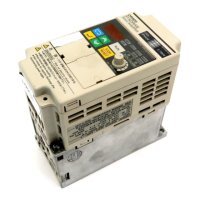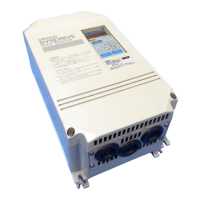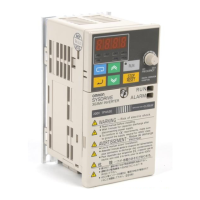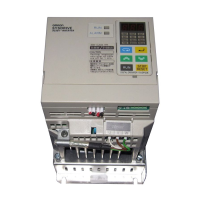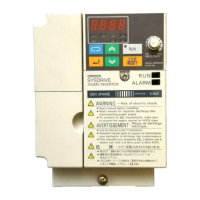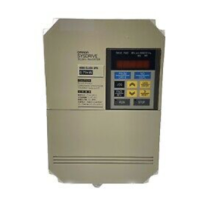8-18
H If the Vertical-axis Load Drops When Brake is Applied
• The sequence is incorrect.
The
Inverter goes into DC braking status for 0.5 seconds after deceleration is completed.
(This is the
factory-set
default.) T
o make sure that the brake holds,
use the frequency detection function and apply
the
brake only when the detected frequency drops to 3 to 5 Hz or lower
. Also at startup, use the
fre
-
quency detection function, and release the brake only when the detected frequency is 3 to 5 Hz or
higher.
• The DC braking is insufficient.
If the DC braking power is insufficient, adjust parameter b2-02 (DC injection braking current).
• An inappropriate brake is being used.
The
holding brake is designed only for holding, not for braking. If the holding brake is used for braking,
the brake pad will wear out much faster than designed. Use an appropriate brake for braking.
H If the Motor Burns Out
• The load is too big.
If
the motor
’
s load is too big and the motor is used with the ef
fective torque exceeding the motor
’
s rated
torque,
the motor will burn out. Also, if the motor
’s inscription states that the motor is rated for eight
hours,
for example, the motor
’
s rated torque and capacity may be limited to eight hours of use. If that
8-hour rated torque is used for normal operation it may cause the
motor to burn out. Reduce the load
amount by either lightening the load or lengthening the acceleration/deceleration time. Also
consider
increasing the motor capacity.
• The ambient temperature is too high.
The
motor
’
s rating is determined within a particular ambient operating temperature range. The motor
will
burn out if it is run continuously at the rated torque in an environment
in which the maximum ambi
-
ent
operating temperature
is exceeded. Lower the motor
’
s ambient temperature to within the accept
-
able ambient operating temperature range.
• The withstand voltage between the motor’s phases is insufficient.
When the motor is connected to the Inverter’s output, a surge is generated between the Inverter’s
switching
and the motor
’
s coil. Normally the maximum surge voltage is three times the Inverter
’s
input
power supply voltage (i.e., 600 V for 200-V class, and 1,200 V for 400-V class). Be sure to use a motor
with a withstand voltage between the motor
’
s phases that is greater than
the
maximum surge voltage.
In particular, when using a 400-V-class Inverter, use a special motor for Inverters.
H If There is Noise When the Inverter is Started or From an AM Radio
If noise is generated by Inverter switching, implement the following measures:
S Lower
the Inverter
’
s carrier frequency (parameter C6-01). This will help to some
extent by reduc
-
ing the amount of internal switching.
S Install
a 3G3EV
-PLNF or 3G3IV
-PFN Input Noise Filter
at the Inverter
’
s power supply input area.
S Install a 3G3IV-PLF Output Noise Filter at the Inverter’s power supply output area.
S Use metal tubing. Electric waves can be shielded by metal, so encase the Inverter with metal
(steel).
H If the Leakage Breaker Operates When the Inverter is Run
The Inverter performs internal switching, so there is a certain amount of leakage current. This may
cause
the leakage breaker to operate and cut of
f the power supply
. Change to a leakage breaker with a
Maintenance Operations Chapter
8
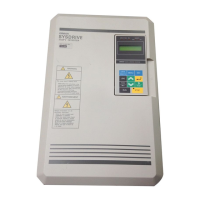
